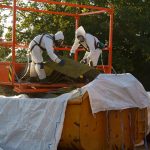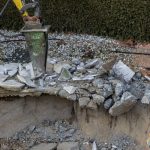What are the steps to follow to demolish a building?
At first glance, demolishing a building may seem like a fun process of smashing it to bits and then collecting the residue.
But in reality, a demolition project can be risky for those who are not familiar with the proper techniques and basic safety rules.
In this article, the experts at the Excavation Chanthier demolition company in Montreal present the steps to follow to demolish a building properly.
Stage 1: Hazardous materials diagnosis
Any controlled building demolition project should be preceded by a thorough decontamination to ensure that no harmful or noxious materials will be released into the environment when the deconstruction takes place. The health of workers, the public and the surrounding ecosystems are at stake.
Before starting any demolition work, it is important that a hazardous materials expert (asbestos, lead, mold, etc.) performs a diagnostic of all materials that should be removed before demolition. When possible, decontamination can take place immediately after the diagnosis, but since materials containing harmful products are sometimes difficult to access, it will generally follow the clearing (a step discussed later in the text).
Stage 2: Organization and planning of the demolition
In order for the demolition of a house or other type of building to go smoothly, the project must be carefully planned. Demolition experts will conduct a structural analysis of the building to provide the answers needed to plan the project. For example, demolishing a house with a party wall may require extra precautions to preserve the integrity of the surrounding buildings.
This preliminary analysis will determine the demolition method and equipment to be used in order to proceed in the safest and most efficient way possible.
Moreover, this analysis will allow the experts to identify the elements that require special attention as well as the supporting structures that must be preserved during the clearing.
Stage 3: Clearing the building to be demolished
During a demolition, not all the materials removed will go to the same place. Naturally, much of the waste will be sent to the landfill, but some will be recycled or reused. However, managing waste disposal after a demolition is very tedious and that’s why clearing has to be done at this point of the project.
In simple terms, clearing consists of removing all installations or materials from the structure that are recyclable or reusable and are not part of a load-bearing element to avoid impairing the stability of the building to be demolished.
Stage 4: Building decontamination
This 4th step is a follow-up to the diagnosis made at the beginning of the project. During this stage, all hazardous materials will be removed from the structure. For example, if asbestos has been found in the insulation materials, asbestos removal will be required before demolition.
Following decontamination, an expert must certify that no contaminants remain in the air or in the materials on the work site. Otherwise, the demolition process cannot continue.
Stage 5: Building demolition
We have finally reached the stage that you have all been waiting for: the demolition of the remaining part of the building. Depending on the planning and organization of the 2nd step, the deconstruction can be done with an excavator or other heavy equipment.
Stage 6: Cleaning the site
After the heavy equipment has passed through, there will be a lot of debris on the demolition site. This is the time to separate the structural elements that can be recycled from the waste and to send the latter to a waste management facility.
Following this last step, the demolition site should be clean and free of debris to avoid accidents and make sure that the land can be used for a new project.
Contact Excavation Chanthier for demolition work done by the book
In conclusion, building demolition should be done according to these different steps in order to guarantee the safety of everyone involved and ensure that as many materials as possible can be recycled or reused.
At Excavation Chanthier, we meticulously orchestrate all of our demolition projects to guarantee our clients’ satisfaction. Whether you are planning a swimming pool demolition or you need to demolish a building that has been destroyed by fire, we always follow the steps outlined in this article.
Contact us today to request a demolition job!







